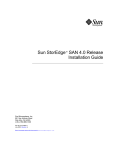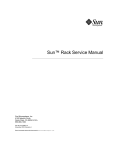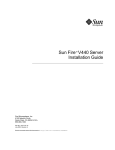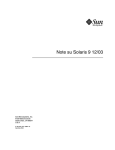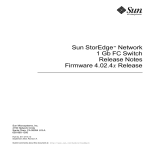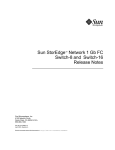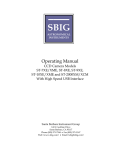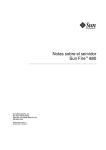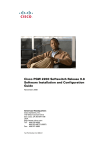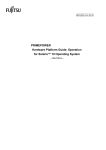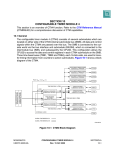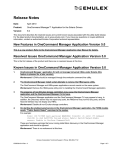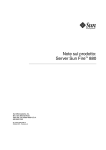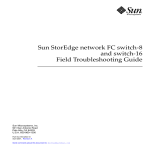Download Sun StorEdge SAN Foundation 4.1 Installation Guide
Transcript
Sun StorEdge™ SAN Foundation Installation Guide Version 4.1 Sun Microsystems, Inc. 901 San Antonio Road Palo Alto, CA 94303 U.S.A. 650-960-1300 Part No. 817-0056-10 October 2002, Revision A Send comments about this document to: [email protected] Copyright 2002 Sun Microsystems, Inc., 4150 Network Circle, Santa Clara, California 95054, U.S.A. All rights reserved. Sun Microsystems, Inc. has intellectual property rights relating to technology embodied in the product that is described in this document. In particular, and without limitation, these intellectual property rights may include one or more of the U.S. patents listed at http://www.sun.com/patents and one or more additional patents or pending patent applications in the U.S. and in other countries. This document and the product to which it pertains are distributed under licenses restricting their use, copying, distribution, and decompilation. No part of the product or of this document may be reproduced in any form by any means without prior written authorization of Sun and its licensors, if any. Third-party software, including font technology, is copyrighted and licensed from Sun suppliers. Parts of the product may be derived from Berkeley BSD systems, licensed from the University of California. UNIX is a registered trademark in the U.S. and in other countries, exclusively licensed through X/Open Company, Ltd. Sun, Sun Microsystems, the Sun logo, docs.sun.com, Sun StorEdge, SunSolve, Solstice DiskSuite, and Solaris are trademarks, registered trademarks, or service marks of Sun Microsystems, Inc. in the U.S. and other countries. All SPARC trademarks are used under license and are trademarks or registered trademarks of SPARC International, Inc. in the U.S. and other countries. Products bearing SPARC trademarks are based upon an architecture developed by Sun Microsystems, Inc. The Energy Star logo is a registered trademark of EPA.The OPEN LOOK and Sun™ Graphical User Interface was developed by Sun Microsystems, Inc. for its users and licensees. Sun acknowledges the pioneering efforts of Xerox in researching and developing the concept of visual or graphical user interfaces for the computer industry. Sun holds a non-exclusive license from Xerox to the Xerox Graphical User Interface, which license also covers Sun’s licensees who implement OPEN LOOK GUIs and otherwise comply with Sun’s written license agreements. Use, duplication, or disclosure by the U.S. Government is subject to restrictions set forth in the Sun Microsystems, Inc. license agreements and as provided in DFARS 227.7202-1(a) and 227.7202-3(a) (1995), DFARS 252.227-7013(c)(1)(ii) (Oct. 1998), FAR 12.212(a) (1995), FAR 52.227-19, or FAR 52.227-14 (ALT III), as applicable. DOCUMENTATION IS PROVIDED "AS IS" AND ALL EXPRESS OR IMPLIED CONDITIONS, REPRESENTATIONS AND WARRANTIES, INCLUDING ANY IMPLIED WARRANTY OF MERCHANTABILITY, FITNESS FOR A PARTICULAR PURPOSE OR NON-INFRINGEMENT, ARE DISCLAIMED, EXCEPT TO THE EXTENT THAT SUCH DISCLAIMERS ARE HELD TO BE LEGALLY INVALID. Copyright 2002 Sun Microsystems, Inc., 4150 Network Circle, Santa Clara, California 95054, Etats-Unis. Tous droits réservés. Sun Microsystems, Inc. a les droits de propriété intellectuels relatants à la technologie incorporée dans le produit qui est décrit dans ce document. En particulier, et sans la limitation, ces droits de propriété intellectuels peuvent inclure un ou plus des brevets américains énumérés à http://www.sun.com/patents et un ou les brevets plus supplémentaires ou les applications de brevet en attente dans les Etats-Unis et dans les autres pays. Ce produit ou document est protégé par un copyright et distribué avec des licences qui en restreignent l’utilisation, la copie, la distribution, et la décompilation. Aucune partie de ce produit ou document ne peut être reproduite sous aucune forme, parquelque moyen que ce soit, sans l’autorisation préalable et écrite de Sun et de ses bailleurs de licence, s’il y ena. Le logiciel détenu par des tiers, et qui comprend la technologie relative aux polices de caractères, est protégé par un copyright et licencié par des fournisseurs de Sun. Des parties de ce produit pourront être dérivées des systèmes Berkeley BSD licenciés par l’Université de Californie. UNIX est une marque déposée aux Etats-Unis et dans d’autres pays et licenciée exclusivement par X/Open Company, Ltd. Sun, Sun Microsystems, le logo Sun, AnswerBook2, docs.sun.com,Sun StorEdge, Solstice DiskSuite, et Solaris sont des marques de fabrique ou des marques déposées, ou marques de service, de Sun Microsystems, Inc. aux Etats-Unis et dans d’autres pays. Toutes les marques SPARC sont utilisées sous licence et sont des marques de fabrique ou des marques déposées de SPARC International, Inc. aux Etats-Unis et dans d’autres pays. Les produits portant les marques SPARC sont basés sur une architecture développée par Sun Microsystems, Inc. Toutes les marques SPARC sont utilisées sous licence et sont des marques de fabrique ou des marques déposées de SPARC International, Inc. aux Etats-Unis et dans d’autres pays. Les produits protant les marques SPARC sont basés sur une architecture développée par Sun Microsystems, Inc. L’interface d’utilisation graphique OPEN LOOK et Sun™ a été développée par Sun Microsystems, Inc. pour ses utilisateurs et licenciés. Sun reconnaît les efforts de pionniers de Xerox pour la recherche et le développment du concept des interfaces d’utilisation visuelle ou graphique pour l’industrie de l’informatique. Sun détient une license non exclusive do Xerox sur l’interface d’utilisation graphique Xerox, cette licence couvrant également les licenciées de Sun qui mettent en place l’interface d ’utilisation graphique OPEN LOOK et qui en outre se conforment aux licences écrites de Sun. LA DOCUMENTATION EST FOURNIE "EN L’ÉTAT" ET TOUTES AUTRES CONDITIONS, DECLARATIONS ET GARANTIES EXPRESSES OU TACITES SONT FORMELLEMENT EXCLUES, DANS LA MESURE AUTORISEE PAR LA LOI APPLICABLE, Y COMPRIS NOTAMMENT TOUTE GARANTIE IMPLICITE RELATIVE A LA QUALITE MARCHANDE, A L’APTITUDE A UNE UTILISATION PARTICULIERE OU A L’ABSENCE DE CONTREFAÇON. Please Recycle Contents Preface 1. i Introduction 1 Features, Benefits, and Products 1 SAN Foundation Device Names On-Demand Node Creation 2 Fabric Connection of Hosts 3 Cascading of Switches 1 3 Higher Realized Bandwidth Support of Multiple Protocols 3 3 Support for New Hardware and Software Software and Hardware Upgrade 3 4 Building Blocks for More Complex Topologies Before You Begin 4 Switch Installation and Activation Software Installation 2. Switch Activation 4 5 5 7 Overall Installation Order 7 Configuring the Switch Ethernet Port 8 Contents 3 Using RARP to Change the IP Address 3. 9 Installing and Upgrading the Sun StorEdge SAN Foundation Kit Software Installing the Software for the First Time 13 Upgrading Existing Sun StorEdge SAN Foundation Kit Software A. Manual Installation of the Sun StorEdge SAN Foundation Kit Software Required Software Components 31 Downloading Patches and Packages Software Installation Sequence B. 32 33 Manual Upgrade of the Sun StorEdge SAN Foundation Kit Software Glossary 4 29 41 Sun StorEdge SAN Foundation Installation Guide • October 2002 37 31 13 Preface The Sun StorEdge SAN Foundation Installation Guide describes how to set up the Sun StorEdge™ SAN Foundation Kit software and configure it to the network. A pointer to additional documentation you may need for configuring, troubleshooting, and using the switch is provided in the documentation that came with your device. The book is intended for technical users who have experience with storage systems. Using UNIX Commands This document may not contain information on basic UNIX® commands and procedures such as shutting down the system, booting the system, and configuring devices. See one or more of the following for this information: ■ Solaris Handbook for Sun Peripherals ■ AnswerBook2™ online documentation for the Solaris™ operating environment ■ Other software documentation that you received with your system i How This Book Is Organized Chapter 1 provides an overview of the features and upgrades the Sun StorEdge SAN Foundation product delivers. Chapter 2 provides instructions on activating a new switch and attaching it to the network. Chapter 3 tells you how to install the new software using the script. Appendix A tells you how to install the software manually. Appendix B provides instructions for upgrading the software manually. Glossary is a list of words and phrases and their definitions. ii Sun StorEdge SAN Foundation Installation Guide • October 2002 Typographic Conventions TABLE P-1 Typeface Meaning Examples AaBbCc123 The names of commands, files, and directories; on-screen computer output Edit your .login file. Use ls -a to list all files. % You have mail. AaBbCc123 What you type, when contrasted with on-screen computer output % su Password: AaBbCc123 Book titles, new words or terms, words to be emphasized Read Chapter 6 in the User’s Guide. These are called class options. You must be superuser to do this. Command-line variable; replace with a real name or value To delete a file, type rm filename. Shell Prompts TABLE P-2 Shell Prompt C shell machine_name% C shell superuser machine_name# Bourne shell and Korn shell $ Bourne shell and Korn shell superuser # Accessing Sun Documentation You can view, print, or purchase a broad selection of Sun documentation, including Preface iii localized versions, at: http://www.sun.com/documentation Sun Welcomes Your Comments Sun is interested in improving its documentation and welcomes your comments and suggestions. You can email your comments to Sun at: [email protected] Please include the part number (817-0056-10) of your document in the subject line of your email. iv Sun StorEdge SAN Foundation Installation Guide • October 2002 CHAPTER 1 Introduction This guide provides instructions for installing the Sun StorEdge SAN Foundation Kit software components. The software components include the drivers that are bundled with the operating system, the firmware for the switches, management tools for the switches and storage devices, volume managers, if needed, and other administration tools. To take advantage of full Fabric support for your SAN, you must upgrade to at least Solaris 8 4/01. For information about how to upgrade your systems, refer to Solaris 8 Installation Supplement, part number 806-5182, available at http://docs.sun.com. For guidance in installing and activating your switch, see: ■ ■ “Features, Benefits, and Products” on page 1 “Before You Begin” on page 4 Features, Benefits, and Products This version of the Sun StorEdge SAN Foundation Kit delivers a large highperforming SAN, with native fabric host connectivity, improved manageability, an integrated multipathing solution (Sun StorEdge Traffic Management software), and support for a variety of new hardware and software products. SAN Foundation Device Names Longer device names in this release mean that additional planning is required. SANs and multipath storage devices require the devices to be addressed by device-specific static global identifiers, and not by physical port ID, which are dynamic in nature and are different across different host’s systems. 1 Traditionally, the Solaris operating environment has named storage devices based on the controller, target ID and logical unit number (LUN) of the device. When large SANs with multiple paths to large storage arrays are constructed, this naming convention could lead to thousands of targets per controller and storage arrays identified more than once by different controllers and targets. The new method incorporates the World Wide Name (WWN) of the device into the device name used by the host. The longer names provide the benefit of uniquely identifying storage devices to the host. When using the Sun StorEdge Traffic Manager software, a device with multiple connections to a host is known to that host by one name. Examples Old device path: /devices/pci@f,4000/pci@4/SUNW,qlc@4/fp@0,0/ssd@3,0 Sun StorEdge Traffic Manager device path: /devices/pci@f,4000/pci@4/SUNW,qlc@4/fp@0,0/ssd@w50020f200000225,0. Old symbolic device name: /dev/dsk/c4t3d0s2 New symbolic designation: /dev/dsk/c18t50060E800000000000004E78000000ABd0s2 is a link to /devices/scsi_vhci/ssd@g50060e800000000000004e78000000ab:c On-Demand Node Creation The number of storage devices that can be attached to a host can grow to the thousands with the advent of SANs with native Fabric connectivity. Probing all these devices at boot time and creating device nodes can increase the boot time greatly. In addition, a host might not need access to all of the storage devices it can access. The Sun StorEdge SAN Foundation software no longer creates device nodes for every storage device attached. Instead, the administrator creates device nodes on demand using the cfgadm utility. The device nodes are persistent across reboots. The cfgadm utility, which provides on-demand node creation, is described in greater detail in the cfgadm_fp (1M) manpage. 2 Sun StorEdge SAN Foundation Installation Guide • October 2002 Fabric Connection of Hosts Hosts can connect to switches in a Fabric topology, using F ports, allowing construction of scalable, high performing SANs. Cascading of Switches Switches can be cascaded to increase the distance between ports available in a zone and across the entire SAN. Cascading of switches allows for distances of up to 10 kilometers between ports, supporting highly available, disaster-tolerant configurations. Higher Realized Bandwidth Host connections to switch Fabric connections (F ports) and interswitch links (ISLs) are full-duplex connections. On a 2 Gb Fibre Channel link, full-duplex connections can provide an aggregate 4 Gb/sec of bandwidth when I/Os are flowing in both directions. Support of Multiple Protocols The Sun StorEdge SAN Foundation product supports both SCSI (FCP) and IP (FCIP) over Fibre Channel. This allows both storage and networking applications to work on the SAN and minimizes the need for multiple networks. Note that software components and patches are what distinguishes the SAN 3.0 from the 4.0 and SAN Foundation releases. FCIP can be used in any supported topology and can be used for traditional IP applications and IP file access at the same time. Simultaneous SCSI and IP traffic in the same switch zone is not currently supported. Support for New Hardware and Software This version of the Sun StorEdge SAN 4.1 software maintains support for new Fibre Channel switches, such as the Sun StorEdge 8-Port switch, Brocade switches, and more. It provides support for the Fabric Tape drive. Chapter 1 Introduction 3 Software support includes Multiplexed I/O Sun StorEdge Traffic Manager, which includes management and load balancing across multiple paths between a host and storage device, Solstice DiskSuite™ volume manager 4.2.1, and the Sun StorEdge Network Data Replicator (SNDR). Software and Hardware Upgrade Upgrading from previous versions of the Sun StorEdge SAN product involves new hardware—2 Gb switches. If you have 1 GB switches, new FC-SW2 compliant software is available and provides new functionality for your switches. If you have 1 Gb switches, and you install this software, your 1 Gb functionality is no longer viable. Building Blocks for More Complex Topologies This version of the SAN introduces configurations with interconnected switches. Cascaded switches allow more reliable, faster, and larger SANs. Before You Begin Before installing or configuring any SAN components, you need to plan how your site will use the SAN and identify your goals in implementing the SAN. There are numerous options at various steps in the installation and configuration process, and understanding the purpose of the SAN clarifies appropriate decisions for your site. Refer to the Sun StorEdge SAN Foundation Configuration Guide for configuration information. Hardware components include: ■ ■ ■ ■ 4 Fibre channel switches Fibre channel host adapters Storage devices Enclosures. Sun StorEdge SAN Foundation Installation Guide • October 2002 Switch Installation and Activation Hardware activation of new switches is covered in this guide. Hardware installation of switches, host adapters and storage devices and enclosures is described in the documentation delivered with those products. ■ Chapter 2,”Switch Activation” tells you how to activate your switch and connect it to the network. Software Installation This guide also describes software installation, starting from an installation or upgrade of Solaris, and including firmware upgrades for any SAN component required. ■ Chapter 3, ““Installing and Upgrading the Sun StorEdge SAN Foundation Kit Software” on page 13” ■ Appendix A, ““Manual Installation of the Sun StorEdge SAN Foundation Kit Software” on page 31” ■ Appendix B, ““Manual Upgrade of the Sun StorEdge SAN Foundation Kit Software” on page 37” Chapter 1 Introduction 5 6 Sun StorEdge SAN Foundation Installation Guide • October 2002 CHAPTER 2 Switch Activation This chapter contains the procedures for bringing the new Sun StorEdge SAN Foundation software onto the network. For more details about the switch, refer to the documentation delivered with your switch. ■ “Overall Installation Order” on page 7 ■ “Configuring the Switch Ethernet Port” on page 8 Overall Installation Order Use this manual, the Sun StorEdge SAN Foundation Configuration Guide, and the documentation that came with your switch. 1. Install the HBAs, connect the hosts, switches and storage devices. 2. If you are running Solaris 8, install the 4/01 release (or newer) operating environment on the host. 3. If you are running Solaris 9, install the FCS or newer release. 4. Install the Recommended and Security Patch cluster on the host. 5. Install the Sun StorEdge SAN Foundation Kit software packages and patches, including any necessary additional software for host bus adapters (HBA). Refer to the HBA documents for more information. For information on the HBA drivers, refer to the documentation associated with them. 6. Assign an IP address to the switch Ethernet port. See “Configuring the Switch Ethernet Port” on page 8. 7 7. Start the GUI for your switch. The user’s manual for your switch contains information about the GUI. 8. Verify and load the switch firmware. 9. Verify and set the domain ID. See “To Set the Network IP Address Using RARP” on page 9. 10. Configure the switch ports. See the Sun StorEdge SAN Foundation Configuration Guide and the installation documentation that came with your switch. 11. Configure and activate zone sets and zones. See the Sun StorEdge SAN Foundation Configuration Guide and the installation documentation that came with your switch. 12. Configure the Fabric devices. See the Sun StorEdge SAN Foundation Configuration Guide and the installation documentation that came with your switch. 13. Enable multipathing (optional). See the documentation for your multipathing application and the installation documentation that came with your switch. 14. Mount the file systems. Configuring the Switch Ethernet Port Note – The following RARP instructions apply to the Sun switch only. Other switch setup procedures can be found in the documentation that came with your switch or is available on the CD that came with the switch, or at the switch web site. The IP address of Sun switches is set to the default value of 10.0.0.1. You can change this default IP address by using either the Reverse Address Resolution Protocol (RARP) or the switch management software supplied with your switch. This guide provides the procedures for changing the IP address using only RARP. 8 Sun StorEdge SAN Foundation Installation Guide • October 2002 Using RARP to Change the IP Address You can use RARP to change the address when you first receive the switch, or if you forget the address, at a later time. The Sun StorEdge SAN Foundation RARP feature automatically downloads the assigned IP address to the switch. After you cable the switch and turn the power on, the IP address is automatically assigned. You will need the following information to change the IP address: IP address ________________________ Contact the person who maintains your network for this information. MAC address _____________________ See the documentation that came with your switch for the location of the MAC address. Switch ____________________________ This is the assigned name of the switch that you are installing. ▼ To Set the Network IP Address Using RARP 1. Verify that the boot method on the switch is set to RARP. RARP is set as the default in the factory. 2. On a host connected to the same subnet as the switch, save your current configuration. 3. Check that the /etc/ethers file exists. # ls /etc/ethers If the ethers file does not exist, create one. 4. If you find the file, create the /etc/ethers.SAV backup file: # cp -p /etc/ethers /etc/ethers.SAV 5. Back up the affected management station configuration files: # cp -p /etc/nsswitch.conf /etc/nsswitch.conf.SAV # cp -p /etc/hosts /etc/hosts.SAV Chapter 2 Switch Activation 9 6. On a host connected to the same subnet as the switch, edit the /etc/ethers file by adding the MAC address and switch name. For example: 8:0:20:7d:93:7e switch-name In this example: ■ 8:0:20:7d:93:7e is the MAC address ■ switch-name is the name of the switch you are installing. 7. Edit the /etc/hosts file with the IP address and switch name. For example: 192.129.122.111 switch-name In this example, 192.129.122.111 is the assigned IP address. 8. Edit the /etc/nsswitch.conf file to reference the local system files. To ensure that the Solaris operating environment uses the changes made to /etc/ethers and /etc/hosts files, edit the host and ethers entries in the /etc/nsswitch.conf file so that the files parameter appears before the [NOTFOUND=return] statements. hosts: ethers: nis files [NOTFOUND=return] nis files [NOTFOUND=return] 9. Determine whether the RARP daemon is running. # ps -eaf | grep rarpd 10. If RARP is not running, start the RARP daemon in the Solaris software environment. # /usr/sbin/in.rarpd -ad The IP address will now automatically download to the switch after you install the switch and power on the system. 10 Sun StorEdge SAN Foundation Installation Guide • October 2002 Note – RARP might not work properly if you have connected the Ethernet port of the switch to an Ethernet switch. This is due to the long time it might take for the Ethernet switch to transmit the RARP. In such a case, you can use the management tools to change the IP address. See the documents that came with your switch. 11. Power off the switch and then power it back on. 12. Verify the switch IP address. # ping ip-address For example: # ping 192.129.122.111 13. If the RARP daemon has started, return to the window in which the daemon was activated and press the Control-C key sequence to the stop the daemon operation. If the IP address is not received from the RARP server, it retries three times before reverting to the original IP address (factory default setting). 14. To return the host to its original state copy the nsswitch.conf, ethers, and hosts files that you saved in Step 5. 15. Make the IP Address Setting Permanent The IP address setting for the switch that you obtain using RARP is not a permanent setting until RARP is disabled. If you have a Sun switch, refer to the SANbox Installer’s/User’s Manual. See the chapter on configuring a switch. If you have a switch from another company, see the documentation delivered with the switch. Chapter 2 Switch Activation 11 12 Sun StorEdge SAN Foundation Installation Guide • October 2002 CHAPTER 3 Installing and Upgrading the Sun StorEdge SAN Foundation Kit Software After you have activated your switch(es), you must install the SAN software. You must have Solaris 8 4/01 or Solaris 9 on your system. ■ “Installing the Software for the First Time” on page 13 ■ “Upgrading Existing Sun StorEdge SAN Foundation Kit Software” on page 29 Installing the Software for the First Time If this is the first time you are installing the SAN software, use the following procedure. If you already have a version of the SAN software on your system, use the upgrade procedure, “Upgrading Existing Sun StorEdge SAN Foundation Kit Software” on page 29. The preferred method of installing or upgrading the software is to use the install_it script. You can obtain the Sun StorEdge install_it script at the Sun Download Center. You can also obtain the README file, README_install_it.txt. http://www.sun.com/storage/san The installation script is a wrapper around packages and patches. In the course of installation, it installs PatchPro. It honors your SVR4 install policies. If you prefer to install the SAN software manually, see Appendix A. 13 If you are using the Solaris 8 Operating Environment with the Sun StorEdge Topology Reporter, after you install the SAN software, you must add the Storage Networking Industry Association (SNIA) packages and the FCSM packages. ▼ To Install the Sun StorEdge SAN Foundation Kit Software for the First Time With the Solaris 8 4/01 Operating Environment 1. Download the installation script and the README file. The install_it script can be downloaded from: http://www.sun.com/storage/san 2. Follow the instructions in the README_install_it.txt file. 3. Become superuser and type Install_it/install_it. The script checks for adequate installation space and makes sure appropriate tools are in place. It then installs or upgrades the required software packages. The following message displays: This routine installs the packages and patches that make up Sun StorEdge SAN. PatchPro will be installed for use with downloading the most up to date versions of the patches. Would you like to continue with the installation? 14 Sun StorEdge SAN Foundation Installation Guide • October 2002 [y,n,?,q] y 4. Type y. Patchpro not installed. Starting installation of Patchpro. This utility will install PatchPro and all required support software. It is a wrapper around pkgadd and patchadd. It will honor your SVR4 install policies and will backout all changes if anything goes wrong. Patches may be applied in support of the installation. For that reason, this utility should be run on a quiet system with no active windowing, preferably in single user mode. If reboot is required, you will see a message at the end of the installation. This installation will preserve critical data files by executing a shell script with root permission. Would you like to continue with the installation? [y,n,?,q] y 5. Type y. Chapter 3 Installing and Upgrading the Sun StorEdge SAN Foundation Kit Software 15 The installation begins and the packages and patches are listed as they are installed. Beginning installation ... Now installing supporting packages... SUNWjhrt == installed successfully SUNWjsse == installed successfully SUNWsdb == installed successfully SUNWapcy == installed successfully SUNWppmn == installed successfully SUNWcert == installed successfully Now installing required patches... 108940-07 == already applied SUNWppro == installed successfully Installation is complete and verified. Be sure to: o Add "/opt/SUNWppro/bin" to your PATH. Set this in your .cshrc or .profile to make it permanent. o If you have not installed the PatchPro patch certificates, see "/opt/SUNWppro/README" for instructions. o If you have not installed the Sun certificates, see "/etc/certs/SUNW/README" for instructions. o Run the "/opt/SUNWppro/bin/uninstallpatchpro" script to uninstall PatchPro. Ready to configure PatchPro Security Certificates. Confirm that the following security certificates are valid. You can find information on security certificates at http://www.sun.com/pki/ca/ Each certificate must be confirmed to complete the installation of PatchPro. 16 Sun StorEdge SAN Foundation Installation Guide • October 2002 The following code example shows a sample .log output for the PatchPro certificates. Importing certificate smicacert Owner: O=Sun Microsystems Inc, CN=Sun Microsystems Inc CA (Class B) Issuer: CN=Sun Microsystems Inc Root CA, O=Sun Microsystems Inc, C=US Serial number: 1000006 Valid from: Mon Nov 13 12:23:10 MST 2000 until: Fri Nov 13 12:23:10 M Certificate fingerprints: MD5: B4:1F:E1:0D:80:7D:B1:AB:15:5C:78:CB:C8:8F:CE:37 SHA1: 1E:38:11:02:F0:5D:A3:27:5C:F9:6E:B1:1F:C4:79:95:E9:6E: Trust this certificate? [no]: yes Certificate was added to keystore Importing certificate smirootcacert Owner: CN=Sun Microsystems Inc Root CA, O=Sun Microsystems Inc, C=US Issuer: CN=GTE CyberTrust Root, O=GTE Corporation, C=US Serial number: 200014a Valid from: Tue Nov 07 15:39:00 MST 2000 until: Thu Nov 07 16:59:00 M Certificate fingerprints: MD5: D8:B6:68:D4:6B:04:B9:5A:EB:34:23:54:B8:F3:97:8C SHA1: BD:D9:0B:DA:AE:91:5F:33:C4:3D:10:E3:77:F0:45:09:4A:E8: Trust this certificate? [no]: yes Certificate was added to keystore Importing certificate patchsigning Owner: CN=Enterprise Services Patch Management, O=Sun Microsystems In Issuer: O=Sun Microsystems Inc, CN=Sun Microsystems Inc CA (Class B) Serial number: 1400007b Valid from: Mon Sep 24 14:38:53 MDT 2001 until: Sun Sep 24 14:38:53 M Certificate fingerprints: MD5: 6F:63:51:C4:3D:92:C5:B9:A7:90:2F:FB:C0:68:66:16 SHA1: D0:8D:7B:2D:06:AF:1F:37:5C:0D:1B:A0:B3:CB:A0:2E:90:D6: Trust this certificate? [no]: yes Certificate was added to keystore Chapter 3 Installing and Upgrading the Sun StorEdge SAN Foundation Kit Software 17 Enter name of your systems proxy server. (Type "local" if you would prefer to not access the remote server.) (Type "clear" if you would prefer to set the Proxy server to nothing. If you are using a proxy server to access the internet and want to obtain the latest patch set, enter the port number of your proxy server now. Otherwise, the install_it program can provide Version 4.1 but no subsequent updates by selecting the local option. 18 Sun StorEdge SAN Foundation Installation Guide • October 2002 Proxy server name : webcache1.central Enter port number of your proxy server Proxy port number : 8080 Proxy setting is correct. Proxy set. PatchPro Configuration Completed. Checking PatchPro for patchadd patches Assessing patches needed for your system... ......................... Retrieved patch list... Downloading patches to /var/spool/pkg/patchpro... ............ /var/spool/pkg/patchpro/112396-02.jar has been validated. /var/spool/pkg/patchpro/108987-09.jar has been validated. . Download of patches completed. Installing patchadd patches patch 112396-02 : Installed Successfully patch 108987-09 : Installed Successfully patchadd patch installation completed. Installing StorEdge SAN packages Package SUNWsan Package SUNWcfpl Package SUNWcfplx : Installed Successfully : Installed Successfully : Installed Successfully StorEdge SAN packages installation completed. Checking PatchPro for StorEdge SAN patches. Assessing patches needed for your system... ........................ Chapter 3 Installing and Upgrading the Sun StorEdge SAN Foundation Kit Software 19 Retrieved patch list... Downloading patches to /var/spool/pkg/patchpro... .............. /var/spool/pkg/patchpro/111412-09.jar has been validated. . /var/spool/pkg/patchpro/111095-11.jar has been validated. /var/spool/pkg/patchpro/111096-04.jar has been validated. /var/spool/pkg/patchpro/111097-10.jar has been validated. . /var/spool/pkg/patchpro/111413-08.jar has been validated. /var/spool/pkg/patchpro/111846-04.jar has been validated. /var/spool/pkg/patchpro/111847-04.jar has been validated. . Download of patches completed. Installing StorEdge SAN patches patch patch patch patch patch patch patch 111412-09 111095-11 111096-04 111097-10 111413-08 111846-04 111847-04 : : : : : : : Installed Installed Installed Installed Installed Installed Installed Successfully Successfully Successfully Successfully Successfully Successfully Successfully StorEdge SAN patch installation completed. Installation of Sun StorEdge SAN completed Successfully 6. Reboot your system. If you are using the Solaris 8 Operating Environment with the Sun StorEdge Topology Reporter, after you install the SAN software, you must add the Storage Networking Industry Association (SNIA) packages and the FCSM packages. ▼ To Install the FCSM Packages 1. Become superuser. 2. Download the SNIA and FCSM packages from http://www.sun.com/storage/san. 20 Sun StorEdge SAN Foundation Installation Guide • October 2002 3. Load the SUNWfcsm and SUNWfcsmx packages. # cd <directory with packages> # pkgadd -d . SUNWfcsm SUNWfcsmx ▼ To Install the SNIA HBA API Common Library 1. Check to see if the Common Library already exists. # ls /usr/lib/libHBAAPI.so # ls /etc/hba.conf If the Common Library has not been installed, the system returns: /usr/lib/libHBAAPI.so: No such file or directory /etc/hba.conf: No such file or directory 2. If neither file exists, install the SUNWcfclr, SUNWcfcl and SUNWcfclx package. # cd <directory with package> # pkgadd -d . SUNWcfclr SUNWcfcl SUNWcfclx 3. Install the SAN Foundation SNIA HBA API Vendor Specific Library. # cd <directory with package> # pkgadd -d . SUNWfchbr SUNWfchba SUNWfchbx 4. Reboot your system. If a previous version of a package is installed, the script removes it and installs the most current one. If the current version of the package is installed, the script does not reinstall it. If the script fails, all of the installed packages and patches, except for PatchPro2.0.1, are removed. If the script fails, you can install the software manually. See Appendix A. Chapter 3 Installing and Upgrading the Sun StorEdge SAN Foundation Kit Software 21 ▼ To Remove the SAN Foundation SNIA HBA API Vendor Specific Library and the FCSM Driver 1. Remove the Vendor Specific Library. # pkgrm SUNWfchbx # pkgrm SUNWfchba # pkgrm SUNWfchbr 2. Remove the FCSM driver. # pkgrm SUNWfcsmx # pkgrm SUNWfcsm 3. Remove the Common Fibre Channel HBA API Libraries. # pkgrm SUNWcfclx # pkgrm SUNWcfclr # pkgrm SUNWcfcl ▼ To Install SAN Software for the First Time With the Solaris 9 Operating Environment 1. Download the installation script. The install_it script can be downloaded from. http://www.sun.com/storage/san 22 Sun StorEdge SAN Foundation Installation Guide • October 2002 2. Become superuser and type install_it. The script checks for adequate installation space and makes sure appropriate tools are in place. It then installs or upgrades the required software packages. The following message displays: This routine installs the packages and patches that make up Sun StorEdge SAN. PatchPro will be installed for use with downloading the most up to date versions of the patches. Would you like to continue with the installation? [y,n,?,q] 3. Type y. Chapter 3 Installing and Upgrading the Sun StorEdge SAN Foundation Kit Software 23 Patchpro not installed. Starting installation of Patchpro. This utility will install PatchPro and all required support software. It is a wrapper around pkgadd and patchadd. It will honor your SVR4 install policies and will backout all changes if anything goes wrong. Patches may be applied in support of the installation. For that reason, this utility should be run on a quiet system with no active windowing, preferably in single user mode. If reboot is required, you will see a message at the end of the installation. This installation will preserve critical data files by executing a shell script with root permission. Would you like to continue with the installation? 4. Type y. 24 Sun StorEdge SAN Foundation Installation Guide • October 2002 [y,n,?,q] Beginning installation ... Now installing supporting packages... SUNWjhrt == installed version is newer SUNWsdb == installed successfully SUNWapcy == installed successfully SUNWppmn == installed successfully SUNWcert == installed successfully SUNWppro == installed successfully Installation is complete and verified. Be sure to: o Add "/opt/SUNWppro/bin" to your PATH. Set this in your .cshrc or .profile to make it permanent. o If you have not installed the PatchPro patch certificates, see "/opt/SUNWppro/README" for instructions. o If you have not installed the Sun certificates, see "/etc/certs/SUNW/README" for instructions. o Run the "/opt/SUNWppro/bin/uninstallpatchpro" script to uninstall PatchPro. Ready to configure PatchPro Security Certificates. Confirm the following security certificates are valid. Information on security certificates can be located at http://www.sun.com/pki/ca/ Chapter 3 Installing and Upgrading the Sun StorEdge SAN Foundation Kit Software 25 Each of the certificate must be confirmed to complete the installation of PatchPro. Importing certificate smicacert Owner: O=Sun Microsystems Inc, CN=Sun Microsystems Inc CA (Class B) Issuer: CN=Sun Microsystems Inc Root CA, O=Sun Microsystems Inc, C=US Serial number: 1000006 Valid from: Mon Nov 13 12:23:10 MST 2000 until: Fri Nov 13 12:23:10 MST 2009 Certificate fingerprints: MD5: B4:1F:E1:0D:80:7D:B1:AB:15:5C:78:CB:C8:8F:CE:37 SHA1: 1E:38:11:02:F0:5D:A3:27:5C:F9:6E:B1:1F:C4:79:95:E9:6E:D6:DF Trust this certificate? [no]: yes Certificate was added to keystore Importing certificate smirootcacert Owner: CN=Sun Microsystems Inc Root CA, O=Sun Microsystems Inc, C=US Issuer: CN=GTE CyberTrust Root, O=GTE Corporation, C=US Serial number: 200014a Valid from: Tue Nov 07 15:39:00 MST 2000 until: Thu Nov 07 16:59:00 MST 2002 Certificate fingerprints: MD5: D8:B6:68:D4:6B:04:B9:5A:EB:34:23:54:B8:F3:97:8C SHA1: BD:D9:0B:DA:AE:91:5F:33:C4:3D:10:E3:77:F0:45:09:4A:E8:A2:98 Trust this certificate? [no]: yes Certificate was added to keystore Importing certificate patchsigning Owner: CN=Enterprise Services Patch Management, O=Sun Microsystems Inc Issuer: O=Sun Microsystems Inc, CN=Sun Microsystems Inc CA (Class B) Serial number: 1400007b Valid from: Mon Sep 24 14:38:53 MDT 2001 until: Sun Sep 24 14:38:53 MDT 2006 Certificate fingerprints: MD5: 6F:63:51:C4:3D:92:C5:B9:A7:90:2F:FB:C0:68:66:16 SHA1: D0:8D:7B:2D:06:AF:1F:37:5C:0D:1B:A0:B3:CB:A0:2E:90:D6:45:0C Trust this certificate? [no]: yes Certificate was added to keystore 26 Sun StorEdge SAN Foundation Installation Guide • October 2002 If you are using a proxy server to access the internet and want to obtain the latest patch set, enter the port number of your proxy server now. Otherwise, the install_it program can provide Version 4.1 but no subsequent updates by selecting the local option. Enter name of your systems proxy server. (Type "local" if you would prefer to not access the remote server.) (Type "clear" if you would prefer to set the Proxy server to nothing.) Proxy server name : webcache1.central Enter port number of your proxy server Proxy port number : 8080 Proxy setting is correct. Proxy set. PatchPro Configuration Completed. Installing StorEdge SAN packages Package SUNWsan Package SUNWcfpl Package SUNWcfplx : Installed Successfully : Installed Successfully : Installed Successfully StorEdge SAN packages installation completed. Chapter 3 Installing and Upgrading the Sun StorEdge SAN Foundation Kit Software 27 Checking PatchPro for StorEdge SAN patches. Assessing patches needed for your system... ........ Retrieved patch list... Downloading patches to /var/spool/pkg/patchpro... .. /var/spool/pkg/patchpro/113039-01.jar has been validated. . /var/spool/pkg/patchpro/113040-02.jar has been validated. /var/spool/pkg/patchpro/113041-01.jar has been validated. . /var/spool/pkg/patchpro/113042-02.jar has been validated. . Download of patches completed. Installing StorEdge SAN patches patch 113039-01 : Broadcast Message from root (rpc.rwalld) on clarity We d Sep 18 18:37:02... From root@clarity: The system clarity will be shut down in 20 minutes Installed Successfully patch 113040-02 : Installed Successfully patch 113041-01 : Installed Successfully patch 113042-02 : Installed Successfully patch 113043-01 : Installed Successfully patch 113044-01 : Installed Successfully patch 111847-04 : Installed Successfully StorEdge SAN patch installation completed. Installation of Sun StorEdge SAN completed Successfully 5. Reboot your system. Note – Manual installation of the SNIA packages and the FCSM packages is not necessary. If you are running the Solaris 9 operating environment, no additional patches are necessary. 28 Sun StorEdge SAN Foundation Installation Guide • October 2002 Upgrading Existing Sun StorEdge SAN Foundation Kit Software Before starting the upgrade, ensure that all required software and patches are accessible. For more information on required software, see Appendix A, TABLE A-2. The upgrade process is almost identical to the process for installing SAN Foundation Kit software for the first time. See “To Install the Sun StorEdge SAN Foundation Kit Software for the First Time With the Solaris 8 4/01 Operating Environment” on page 14 for instructions. If you are using the Solaris 8 Operating Environment with the Sun StorEdge Topology Reporter v1.0, after you install the SAN software, you must add the Storage Networking Industry Association (SNIA) packages and the FCSM packages. See “To Install the FCSM Packages” on page 20 and “To Install the SNIA HBA API Common Library” on page 21. See “To Remove the SAN Foundation SNIA HBA API Vendor Specific Library and the FCSM Driver” on page 22. If you are running the Solaris 9 Operating Environment, see “To Install SAN Software for the First Time With the Solaris 9 Operating Environment” on page 22. If the script fails, or you want to install the SAN software manually, see Appendix B. Chapter 3 Installing and Upgrading the Sun StorEdge SAN Foundation Kit Software 29 30 Sun StorEdge SAN Foundation Installation Guide • October 2002 APPENDIX A Manual Installation of the Sun StorEdge SAN Foundation Kit Software This appendix contains the following topics that describe how to install the Sun StorEdge SAN Foundation Kit (SFK) and associated software if you chose the manual method: ■ ■ “Required Software Components” on page 31 “Downloading Patches and Packages” on page 32 The SFK software supports devices in a SAN or direct attach configurations. Required Software Components The following software components might be required for your particular SAN system. Refer to the documentation for each individual product to ensure proper installation. Software Components Some of the components are required and some are optional but recommended. Required ■ The Sun StorEdge SAN Foundation Kit packages, which include the cfgadm packages. for Fabric on-demand node creation 31 This component is delivered with the Solaris software upgrades for the FC switch product. It is used to discover SAN-attached devices, in addition to creating and deleting nodes for those devices. These features are implemented through the cfgadm framework. See the cfgadm_fp(1M) man page for additional information. ■ Sun StorEdge Traffic Manager Software (STMS) This is available as a package with a patch that can be installed on a system running at least Solaris 8 4/01. It should be installed with the latest revision of the Sun StorEdge Network Foundation Kit software. Optional ■ Solstice DiskSuite Solstice DiskSuite software is an optional but recommended unbundled product that is delivered with the Solaris software. The Solstice DiskSuite provides host-based storage management, such as mirroring and striping of disks, which provides greater reliability and volume size. The Solstice DiskSuite 4.2.1 software also implements RAID 5. ■ VERITAS Volume Manager VERITAS Volume Manager is an optional but recommended separately installed software product that provides host-based storage management, such a disk labeling, mirroring, striping, and RAID 5. ■ SNIA and FCSM SNIA and FCSM allow you access to the Common Libraries. Downloading Patches and Packages You can download the required patches and packages for SFK and STMS from the web sites listed in TABLE A-1. Follow the installation order defined in TABLE A-2. TABLE A-1 32 Packages and Patches Download Web Sites Software Downloading Web Site Packages http://www.sun.com/storage/san Patches http://sunsolve.sun.com Sun StorEdge SAN Foundation Installation Guide • October 2002 Software Installation Sequence The software components listed in TABLE A-2 are required for SFK and STMS support on your SAN. You must install them in the sequence outlined; but always follow the installation instructions in the README file contained in each patch or package. The patches listed below are the minimum patch level. After adding all of the packages and patches to your system, reboot it. Software Component Installation Sequence TABLE A-2 Step Number Solaris 8 OE Package or Patch Solaris 9 OE Package or Patch 1 SUNWsan SUNWsan Sun StorEdge Network Foundation 2 111847-05 111847-05 SAN Foundation Kit patch 3 111412-10 113039-02 Sun StorEdge Traffic Manager 4 111095-12 113040-03 fcp/fp/fctl drivers patch 5 111096-05 113041-02 fcip driver patch 6 111097-11 113042-03 qlc driver patch 7 111413-09 113043-02 luxadm and libg_fc/liba5k 8 SUNWcfpl, SUNWcfplx SUNWcfpl, SUNWcfplx cfgadm fp port driver specific library 9 111846-05 113044-02 cfgadm fp plug-in library patch 10 110614-021 11 SUNWfchba SUNWfchba Sun Fibre Channel Host Bus Adapter Library 12 SUNWfchbr SUNWfchbr Sun Fibre Channel Host Bus Adapter Library (Root) 13 SUNWfchbx SUNWfchbx Sun Fibre Channel Host Bus Adapter Library (Usr) (64-bit) 14 SUNWfcsm SUNWfcsm FCSM driver Appendix A Software Component ses driver patch Manual Installation of the Sun StorEdge SAN Foundation Kit Software 33 TABLE A-2 Software Component Installation Sequence (Continued) Step Number Solaris 8 OE Package or Patch Solaris 9 OE Package or Patch Software Component 15 SUNWfcsmx SUNWfcsmx FCSM driver (64-bit) 16 SUNWcfcl SUNWcfcl Common Fibre Channel HBA API Library (Usr) 17 SUNWcfclr SUNWcfclr Common Fibre Channel HBA API Library (Root) 18 SUNWcfclx SUNWcfclx Common Fibre Channel HBA API Library (Usr) (64-bit) 19 113766-01 Common Fibre Channel HBA API Library 20 113767-01 SNIA Sun Fibre Channel Host Bus Adapter Library 1. Patch might have been included with the operating environment.. ▼ To Download the Packages 1. Go to the following web site: http://www.sun.com/storage/san/ 2. At the bottom of the page, under “Get the Software,” select “Sun StorEdge [tm] SAN 4.1 release Software/Firmware Upgrades and Documentation”. 3. Register, if you have not already; otherwise enter your registration information. 4. Click Accept and Continue on the Legal/License Agreement page. 5. Click the link for the packages for your operating environment. For the Solaris 8 operating environment, click “Solaris 8 SUNWcfpl/x and SUNWsan packages (Solaris_8_SFK_packages.tar.Z)“. For the Solaris 9 operating environment, click “Solaris 9 SUNWcfpl/x and SUNWsan packages (Solaris_9_SFK_packages.tar.Z)“ 34 Sun StorEdge SAN Foundation Installation Guide • October 2002 ▼ To Download the Patches 1. Go to http://sunsolve.sun.com. 2. Download patches listed in TABLE A-2. a. Click Patches b. Click PatchPro. c. Under PatchPro Interactive, click Network Storage Products. d. Fill out the fields for OS Release, Platform, and SAN Products. Specify 4.1 in the SAN Products field. e. Optionally, you can also fill out the fields for Disk Arrays Libraries, Disk Drives, Software, Tape Drives, Switches and HBAs. If you fill out these fields, you will get more patches than those listed in TABLE A-2. You need only the ones in TABLE A-2. f. Click Generate Patch List to generate a list of patches. Select the desired patches and click Download selected patches. 3. Move the patches to the machine on which you intend to install the software. 4. Unzip the patches. ▼ To Install the Patches Install the packages before you install the patches. ● Use the patchadd command to install the patches in TABLE A-2. Follow the installation sequence listed in TABLE A-2. ▼ An Example of Installing the Packages and Patches Follow the installation sequence in TABLE A-2. 1. Install the SUNWsan package for the Sun StorEdge SAN Foundation Kit software. # pkagdd -d pkg-location SUNWsan Appendix A Manual Installation of the Sun StorEdge SAN Foundation Kit Software 35 2. Install the Sun StorEdge SAN Foundation Kit patch. # patchadd patch-location/11847-05 3. Install the remaining patches. Use the correct patch for your Solaris 8 or Solaris 9 Operating Environment. See TABLE A-2. In the following example, the patches are for the Solaris 8 Operating Environment. # patchadd patch-location/111412-10 111095-12 111096-05 111097-11 11413-09 4. Install the cfgadm plug-in library packages SUNWcfpl and SUNWcfplx. # pkgadd -d pkg-location SUNWcfpl # pkgadd -d pkg-location SUNWcfplx 5. Install the cfgadm fp plug-in library patch. # patchadd patch-location/110614-02 6. Install the rest of the packages and patches as shown on TABLE A-2. 7. Reboot the system. For each storage device, upgrade the software, firmware, or configuration. See the Sun StorEdge San Foundation Configuration Guide. Upgrade the components to the revision levels outlined in “Software Component Installation Sequence” on page 33. 36 Sun StorEdge SAN Foundation Installation Guide • October 2002 APPENDIX B Manual Upgrade of the Sun StorEdge SAN Foundation Kit Software This appendix contains the following topics regarding how to upgrade your SAN system to the latest version by the manual method. Caution – The Sun StorEdge SAN Foundation software obsoletes some older hardware, such as the Sun StorEge A3500 and the A5x00, as well as some FC tape drives. ▼ To Upgrade the SAN Software 1. Verify the upgrade compliance. Before starting the upgrade, ensure that your system is stable and that all required software and patches are accessible. For more information on required software, see Appendix A. 2. Download the patches. See TABLE A-1 on page 32 for all the locations of patches and packages to download. Download all patches to the host prior to beginning the upgrade procedure. Patches are available at the Sun Download Center. http://www.sun.com/storage/san 3. Follow the procedure “To Install the Patches” on page 35. 37 ▼ Preparing to Upgrade the Software If you have multiple hosts on your SAN, you can upgrade them simultaneously, or one at a time, without affecting your SAN environment. Hosts that are not being upgraded will not be affected during the upgrade. You can upgrade the host software one host at a time or several hosts in parallel. Caution – You may lose formerly supported devices if you continue. Caution – Your system will be unavailable to users and the SAN during the upgrade procedure. The order in which the SAN components should be upgraded follows: 1. Familiarize yourself with the required software components, versions and patches. See Appendix A for the current list of required software. 2. Back up all data. If you are using the Solstice DiskSuite software as your volume manager, you must upgrade your operating system. Refer to the Solstice DiskSuite 4.2.1 Reference Guide for instructions. If you are using VERITAS Volume Manager, refer to the VERITAS Volume Manager Installation Guide for special instructions about upgrading your system. There are several steps you must perform before you upgrade your system. 3. Upgrade the Solaris Operating Environment. To take advantage of full Fabric support for your SAN, you must upgrade to at least Solaris 8 4/01. For information about how to upgrade your system, refer to the Solaris 8 Installation Supplement. ▼ To Install the Software 1. Follow the procedure on in Appendix A. 38 Sun StorEdge SAN Foundation Installation Guide • October 2002 ▼ To Set Up the System as a SAN Management Host If this system is being used as a SAN management host, follow the steps in this section. 1. Upgrade the storage firmware and configuration. For each storage device, upgrade the software, firmware, or configuration. Upgrade the components to the revision levels outlined in the Sun StorEdge SAN Foundation Configuration Guide. 2. Reboot the system. 3. For each of the storage devices, upgrade the software, firmware, or configuration. Upgrade the components to the revision levels outlined in Sun StorEdge SAN Foundation Configuration Guide. You can leverage additional features provided by the Sun StorEdge SAN Foundation software by configuring the SAN for: ■ ■ ■ ■ 2 Gb switches 2 Gb host bus adapters Heterogeneous switches Large configuration support Appendix B Manual Upgrade of the Sun StorEdge SAN Foundation Kit Software 39 40 Sun StorEdge SAN Foundation Installation Guide • October 2002 Glossary This glossary contains a definitions for terms used in this guide. A AL_PA arbitrated loop physical address. An eight-bit value used to identify a device attached to a Fibre Channel arbitrated loop. Ap_Id attachment point identifier. The port identifier for either a host or a storage device connected to a switch. For example, c0 identifies the host port and c0::50020f23000063a9 identifies an array. C Cascade The connection of two or more switches to increase the number of available ports or to allow for increased distances between components of the SAN. E E port Expansion port. The port used to connect FC-SW2-compliant switches to one another. F port Fabric port. The switch port on a Fibre Channel used to connect to the Fabriccapable storage devices, such as a Sun StorEdge T3+ array, a Sun StorEdge 39x0, 69x0 and 99x0 series, or a host bus adapter. 41 Fabric One or more switches in a Fibre Channel network. It is also common to refer to something as a "Fabric device" or being in "Fabric mode." FC-SW-2 The second generation of the Fibre Channel Switch Fabric Standard defined by ANSI. G G port Generic port. A port that can operate as either an E port or F port. A port is defined as a G port when it is not yet connected or has not yet assumed a specific function in the fabric. I initiator A host bus adapter port connection that provides a path to a storage device. An active initiator provides a path that is online. An inactive initiator provides a standby path when the Sun StorEdge Traffic Manager software is enabled. ISL inter switch link. A segment or cable that connects two cascaded switches. The ISL does not include cables from the host to the switch or from storage devices to the switch. L LUN logical unit number. N N port NAS 42 A Fibre Channel port that supports point-to-point or Fabric connections. network-attached storage. Sun StorEdge SAN Foundation Installation Guide • October 2002 P private loop A Fibre Channel Arbitrated Loop (FC-AL) with 8-bit addressing that supports up to 126 device connections with no Fabric attachment (F and FL ports). Private loops are closed systems that are incapable of seeing outside the loop. public loop An arbitrated loop that supports Fabric login and services. A public loop provides 24-bit Fibre Channel addressing and up to 16 million node connections Fabric wide. It uses name server (NS) ports. T T Port Transfer or Trunk port. A switch port from the SAN 3.0 release used to connect to other switches in a cascade. T ports are used to attach a port on one switch to a port on another switch. T ports are replaced by E ports in the SAN 4.0 release. TL Port Translative Loop port. A port on the switch that enables private-to-public and public-to-private loop connectivity. The TL Port presents private devices to a Fabric as if they were public so they can communicate with the off-loop devices, such as public devices connected to F ports and FL ports and private devices on other TL port loops. The ports support the Sun StorEdge T3 arrays. Hosts recognize arrays that use TL ports as Fabric devices. W WWW world wide name. Z zone A set of ports or WWNs and their connected devices that have been grouped together to control information exchange. Glossary 43 zoning 44 A function of the switch that enables the segregation of devices. Zoning is done for a variety of reasons, such as security, simplicity, performance, and dedication of resources. Sun StorEdge SAN Foundation Installation Guide • October 2002




















































